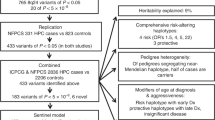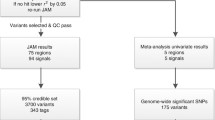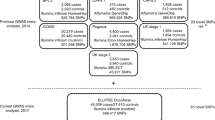Abstract
The tumor suppressor functions of PTEN and CDKN1B have been extensively characterized. Recent data from mouse models suggest that, for some organs, the combined action of both PTEN and CDKN1B has a stronger tumor suppressor function than each alone; for the prostate, heterozygous knockout of both genes leads to 100% penetrance for prostate cancer. To assess whether such an interaction contributes to an increased risk of prostate cancer in humans, we performed a series of epistatic PTEN and CDKN1B interaction analyses in a collection of 188 high-risk hereditary prostate cancer families. Two different analytical approaches were performed; a nonparametric linkage (NPL) regression analysis that simultaneously models allele sharing at these two regions in all families, and an ordered subset analysis (OSA) that assesses linkage evidence at a target region in a subset of families based on the magnitude of allele sharing at the reference region. The strongest evidence of interaction effect was observed at 10q23-24 and 12p11-13 from both the NPL regression analysis (P=0.0002) in all families and the OSA analyses in subsets of families. A LOD-delta of 3.15 (P=0.01) was observed at 10q23-24 among 54 families with the highest NPL scores at 12p11-13, and a LOD-delta of 2.63 (P=0.02) was observed at 12p11-13 among 34 families with the highest NPL scores at 10q23-24. The evidence for the interaction was stronger when using additional fine-mapping markers in the PTEN (10q23) and CDKN1B (12p13) regions. Our data are consistent with epistatic interactions between the PTEN and CDKN1B genes affecting risk for prostate cancer and demonstrate the utility of modeling epistatic effects in linkage analysis to detect susceptibility genes of complex diseases.



Similar content being viewed by others
References
Cairns P, Okami K, Halachmi S, Halachmi N, Esteller M, Herman JG, Jen J, Isaacs WB, Bova GS, Sidransky D (1997) Frequent inactivation of PTEN/MMAC1 in primary prostate cancer. Cancer Res 57:4997–5000
Chang BL, Zheng SL, Isaacs SD, Wiley KE, Turner A, Li G, Walsh PC, Meyers DA, Isaacs WB II, Xu J (2004) The polymorphism in the CDKN1B gene is associated with increased risk of hereditary prostate cancer. Cancer Res 64:1997–1999
Cordon-Cardo C, Koff A, Drobnjak M, Capodieci P, Osman I, Millard SS, Gaudin PB, Fazzari M, Zhang ZF, Massague J, Scher HI (1998) Distinct altered patterns of p27KIP1 gene expression in benign prostatic hyperplasia and prostatic carcinoma. J Natl Cancer Inst 90:1284–1291
Davis CC, Brown WM, Lange EM, Rich SS, Langefeld CD (2001) Nonparametric linkage regression. II. Identification of influential pedigrees in tests for linkage. Genet Epidemiol 21(Suppl 1): S123–S129
Di Cristofano A, Pesce B, Cordon-Cardo C, Pandolfi PP (1998) Pten is essential for embryonic development and tumour suppression. Nat Genet 19:348–355
Di Cristofano A, De Acetis M, Koff A, Cordon-Cardo C, Pandolfi PP (2001) Pten and p27KIP1 cooperate in prostate cancer tumor suppression in the mouse. Nat Genet 27:222–224
Hauser ER, Watanabe RM, Duren WL, Bass MP, Langefeld CD, Boehnke M (2004) Ordered subset analysis in genetic linkage mapping of complex traits. Genet Epidemiol 10.1002/gepi.2000
Hermans KG, Van Alewijk DC, Veltman JA, Van Weerden W, Van Kessel AG, Trapman J (2004) Loss of a small region around the PTEN locus is a major chromosome 10 alteration in prostate cancer xenografts and cell lines. Genes Chromosomes Cancer 39:171–184
Isaacs WB, Xu J, Walsh PC (2001) Hereditary prostate cancer. In: Chung LWK, Isaacs WB, Simons JW (eds) Prostate cancer, biology, genetics, and the new therapeutics. Humana, New Jersey, pp 13–28
Jemal A, Murray T, Samuels A, Ghafoor A, Ward E, Thun MJ (2003) Cancer statistics, 2003. CA Cancer J Clin 53:5–26
Kibel AS, Schutte M, Kern SE, Isaacs WB, Bova GS (1998) Identification of 12p as a region of frequent deletion in advanced prostate cancer. Cancer Res 58:5652–5655
Komiya A, Suzuki H, Ueda T, Yatani R, Emi M, Ito H, Shimazaki J (1996) Allelic losses at loci on chromosome 10 are associated with metastasis and progression of human prostate cancer. Genes Chromosomes Cancer 17:245–253
Kong A, Cox NJ (1997) Allele-sharing models: LOD scores and accurate linkage tests. Am J Hum Genet 61:1179–1188
Langefeld CD (1999) The application of statistical methods for highly stratified data to linkage and association analyses of complex genetic traits. PhD Thesis, University of Michigan
Langefeld CD, Davis CC, Brown WM (2001) Nonparametric linkage regression I: combined Caucasian CSGA and German genome scans for asthma. Genet Epidemiol 21:S136-S141
Liang J, Zubovitz J, Petrocelli T, Kotchetkov R, Connor MK, Han K, Lee JH, Ciarallo S, Catzavelos C, Beniston R, Franssen E, Slingerland JM (2002) PKB/Akt phosphorylates p27, impairs nuclear import of p27 and opposes p27-mediated G1 arrest. Nat Med 8:1153–1160
Lu Y, Lin YZ, LaPushin R, Cuevas B, Fang X, Yu SX, Davies MA, Khan H, Furui T, Mao M, Zinner R, Hung MC, Steck P, Siminovitch K, Mills GB (1999) The PTEN/MMAC1/TEP tumor suppressor gene decreases cell growth and induces apoptosis and anoikis in breast cancer cells. Oncogene 18:7034–7045
Medema RH, Kops GJ, Bos JL, Burgering BM (2000) AFX-like forkhead transcription factors mediate cell-cycle regulation by Ras and PKB through p27kip1. Nature 404:782–787
Paramio JM, Navarro M, Segrelles C, Gomez-Casero E, Jorcano JL (1999) PTEN tumour suppressor is linked to the cell cycle control through the retinoblastoma protein. Oncogene 18:7462–7468
Parsons R, Simpson L (2003) PTEN and cancer. Methods Mol Biol 222:147–166
Philipp-Staheli J, Payne SR, Kemp CJ (2001) p27(Kip1): regulation and function of a haploinsufficient tumor suppressor and its misregulation in cancer. Cell Res 264:148–168
Podsypanina K, Ellenson LH, Nemes A, Gu J, Tamura M, Yamada KM, Cordon-Cardo C, Catoretti G, Fisher PE, Parsons R (1999) Mutation of Pten/Mmac1 in mice causes neoplasia in multiple organ systems. Proc Natl Acad Sci USA 96:1563–1568
Shin I, Yakes FM, Rojo F, Shin NY, Bakin AV, Baselga J, Arteaga CL (2002) PKB/Akt mediates cell-cycle progression by phosphorylation of p27(Kip1) at threonine 157 and modulation of its cellular localization. Nat Med 8:1145–1152
Suzuki A, Pompa JL de la, Stambolic V, Elia AJ, Sasaki T, Barco Barrantes I del, Ho A, Wakeham A, Itie A, Khoo W, Fukumoto M, Mak TW (1999) High cancer susceptibility and embryonic lethality associated with mutation of the PTEN tumor suppressor gene in mice. Curr Biol 8:1169–1178
Suzuki H, Freije D, Nusskern DR, Okami K, Cairns P, Sidransky D, Isaacs WB, Bova GS (1998) Interfocal heterogeneity of PTEN/MMAC1 gene alterations in multiple metastatic prostate cancer tissues. Cancer Res 58:204–209
Vanhaesebroeck B, Alessi DR (2000) The PI3 K-PDK1 connection: more than just a road to PKB. Biochem J 346:561–576
Whittemore A, Halpern J (1994) A class of tests for linkage using affected pedigree members. Biometrics 50:118–127
Wu X, Senechal K, Neshat MS, Whang YE, Sawyers CL (1998) The PTEN/MMAC1 tumor suppressor phosphatase functions as a negative regulator of the phosphoinositide 3-kinase/Akt pathway. Proc Natl Acad Sci USA 95:15587–15591
Xu J, Gillanders EM, Isaacs SD, Chang BL, Wiley KE, Zheng SL, Jones M, Gildea D, Riedesel E, Albertus J, Freas-Lutz D, Markey C, Meyers DA, Walsh PC, Trent JM, Isaacs WB (2003) Genome-wide scan for prostate cancer susceptibility genes in the Johns Hopkins hereditary prostate cancer families. Prostate 57:320–325
Acknowledgements
The authors thank all the study subjects who participated in this study. This work was partially supported by PHS SPORE CA58236, a grant from the Department of Defense to J.X (DAMD17-00-1-0087) and a grant (CA095052) from NCI to J.X.
Author information
Authors and Affiliations
Corresponding author
Additional information
Jianfeng Xu and Carl D. Langefeld contributed equally to this work
Rights and permissions
About this article
Cite this article
Xu, J., Langefeld, C.D., Zheng, S.L. et al. Interaction effect of PTEN and CDKN1B chromosomal regions on prostate cancer linkage. Hum Genet 115, 255–262 (2004). https://doi.org/10.1007/s00439-004-1144-4
Received:
Accepted:
Published:
Issue Date:
DOI: https://doi.org/10.1007/s00439-004-1144-4




